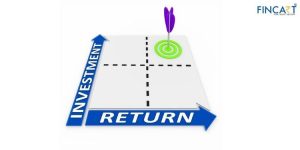Table of Contents
ToggleRemember the good old days? When we’d save every rupee in that trusty gullak, and all our pocket money to buy games and chocolates and whatnot? You grow up and realise, things haven’t changed much, except their scale. Now you may dream of buying a new house, but for that just saving money isn’t very wise. Inflation eats into the value of your money, so you end up paying more and it takes longer. If you invest your money, however, you can buy your dream home faster, while protecting the value of your money. But where should you invest? With many options, starting the investment planning journey can feel overwhelming. But fear not!
If you’re just getting started or looking for some investing tips, you’ve found the perfect investment planning guide! From investment planning definition and process to importance and common pitfalls, we’ll cover it all. Let’s begin!
What is Investment Planning?
Investment planning is a key aspect of financial planning that focuses on aligning your investments with your financial goals. It involves assessing your current financial situation, identifying future financial objectives, and creating a strategy to achieve them. This process includes selecting the right mix of investment options based on factors such as risk tolerance, time horizon, and return expectations.
Investment Planning Process
Let’s take a look at five simple steps to understand How to Make an Investment Plan:
1. Assessment of Current Financial Situation
Your investment planning journey begins by having a clear understanding of your current financial standing. You can assess your financial situation by taking factors such as income, expenses, liabilities, savings, and assets into account. Include income from all sources such as salary, business, freelance income, rental income, bank fixed deposit interest, and dividends. The savings include the cash you have in your bank account and emergency funds. The assets include all properties, cars, investments, jewellery etc, and liabilities include debt such as credit card debt, mortgage, education loan and so on.
By assessing these factors, you can calculate your net worth by simply subtracting your total liabilities from your total asset value. Net worth can help you track your progress and set realistic financial goals, and by knowing your income and expenses, you can make a realistic budget that can help you save the money you need to realise those goals. It will also give you some insights into your risk tolerance and capacity for investment by telling you how much you can afford to invest and its allocation. Over the years as your net worth grows, you will feel more confident and motivated.
2. Setting Investment Objectives
After you’ve assessed your financial situation and calculated your net worth, the next step is to set clear and realistic investment goals. Your goal may be long-term like building a retirement corpus, building wealth, funding your child’s education, or buying a new home, or it may have a shorter time horizon like going on a vacation or buying a vehicle. Before you invest to realise these dreams, you have to save money. That’s why assessment – the first step is so important. When you know all about what’s coming in and how much is going out, you can identify areas where you can make cutbacks and save more.
Let’s take an example. Imagine your goal is to build an emergency fund. In an emergency fund, you should aim to have at least six months of your living expenses. These include essential expenses such as rent, groceries, and bills, as well as your SIPs, insurance premiums, EMI payments, and transportation, so your life doesn’t stop in case of unforeseen circumstances.
With a clear overview of your financial situation, you will be able to determine your monthly living expenses and save accordingly. These goals must be SMART – Specific, Measurable, Attainable, Realistic, and Time-bound. Continuing the example, if your living expenses are Rs. 40,000 per month, you’d need an emergency fund of at least Rs. 2,40,000. Your SMART goal could be something like “I will aim to save Rs. 20,000 each month for 12 months in a high-interest savings account to build my emergency fund.” This gives you a specific target, a defined time horizon, and a clear direction.
Make sure that your goals are realistic. Adapt to your financial circumstances and avoid making too many sacrifices or setting hard-to-attain goals. This is important because realistic goals keep you motivated and you are more likely to achieve them. Combined, these first two steps give you a solid foundation to build your investment plan.
3. Developing an Investment Strategy
Now you need a plan of action to achieve your financial goals. Your investment strategy will guide your decisions based on factors like income, age, risk tolerance, investible surplus, future capital requirements, and more. Investment strategies can be safe – meaning your focus is to preserve your money and grow steadily by investing in safe avenues such as debt mutual funds or Public Provident Funds.
They can be moderate, meaning they have a balanced approach by combining a mix of stable investments like hybrid mutual funds to achieve steady growth while mitigating risk. Or they can be aggressive, which means taking on high risk to potentially reap high rewards by investing in products such as equities or equity mutual funds.
Let’s take some simple examples to get a better idea of investment strategies. Investors who start their retirement planning early can be aggressive and take on more risk than individuals starting late, and build a significantly larger nest egg. This is because they have time on their side, and with time they can make back any losses they may take in the short term.
Similarly, If someone’s monthly income is low, they cannot afford to take risks and lose money and should prioritise safe investments that offer steady returns. Some investors may need a monthly income, so they may invest a lump sum to generate regular income through avenues such as dividend-paying stocks or rental properties.
There are also different styles of investing – With an active style, investors have a hands-on approach to managing their investments, and they regularly buy and sell assets in an attempt to outperform the market returns or achieve specific financial goals. Passive investors, however, buy and hold a diversified portfolio of assets to match rather than outperform market returns while minimising transaction costs and effort.
A stock investor may prefer value stocks, which trade for less than their intrinsic value. On the other hand, some stock investors prefer stocks that show strong potential for future growth, called growth investing.
4. Implementation
There are many different kinds of financial products in the market suited to different kinds of investors and investment strategies. The next step is to understand these products and select the suitable ones. When you’re researching or consulting advisors about them, remember to understand the tax implications of different instruments. Also before committing, see if there are any lock-in periods associated. If so, check the penalties or exit fees that come with them.
As per your goals, risk tolerance and time horizon, determine the optimal asset allocation. If your main goal is to build a retirement fund, you can allocate more funds to equity products, or if you’re chasing a short-term goal, it’s better to focus on debt instruments. You must have heard the phrase “Don’t put all your eggs in one basket.” When you are building your portfolio, it is very important to diversify. Diversification mitigates risks and makes sure that if one asset class fails, your overall portfolio is not impacted too much.
There are also different ways you can invest in products, such as through Systematic Investment Plans (SIPs) or lump sum payments in case of bank fixed deposits or properties. You need a demat account to get started on mutual fund SIPs or shares trading, which can be set up online. You can go to a post office to invest in schemes such as PPF, NPS, and NSC.
5. Monitoring and Reviewing
Now that you’ve opened your accounts and made your investments, the final step is to continuously monitor them. You have to assess how your investments are doing and rebalance your portfolio based on asset performance, market conditions, and changes to your own financial situation. You should review your portfolio quarterly or semi-annually, or at the very least once per year to make sure it stays aligned with your financial goals.
Ready to grow your wealth?
Partner with Fincart for expert investment planning and make your money work for you.
Importance of Professional Investment Advice
Here’s why seeking professional investment advice can be a game changer:
- An investment advisor takes your unique financial situation into account, and based on your financial goals, risk tolerance, and time horizon can make a customised plan.
- While you can research the many financial products on your own, a professional can use his experience and expertise to guide you, save you from misinformation, and help you avoid middlemen.
- Investors are often influenced by schemes that have brought success to their friends or relatives, but remember that their financial circumstances do not align with yours. A financial advisor is objective in this regard and does unbiased investment planning.
- Financial advisors save you precious time and effort by conducting thorough research and managing your investments. This allows you to focus on other aspects of your life, and live with peace of mind.
- Investment advisors can help you determine the ideal asset allocation and diversify your investment portfolio effectively to minimise risk and maximise returns.
- They can also inform you about the tax implications of your investments, and suggest tax-saving investment options so you can maximise the deductions and exemptions, and reduce your tax liabilities.
- Investment advisors monitor your portfolio for you and keep you updated about the changes in market trends and laws. They make sure your portfolio adapts to changing circumstances and stays aligned with your financial goals.
Common Mistakes to Avoid in Investment Planning
The investment planning process can be a bit complex. Here are some common mistakes beginners make that one should avoid:
- Remember that your financial situation is unique, so don’t invest based on emotions or recommendations by friends and relatives.
- If you’re investing through a SIP, make sure your contributions are regular.
- Never put all your eggs in one basket. Diversify your investment portfolio across different asset classes such as stocks, mutual funds, gold, REITs, and bonds to mitigate risk.
- Don’t ignore the tax implications as you may miss opportunities to reduce your tax liabilities, or add to them.
- Review your portfolio regularly, at least once a year to stay on top of the changes and readjust your portfolio to ensure that it stays aligned with your financial goals.
- While past performance is an effective indicator of a scheme, don’t invest based on good past performance alone as it doesn’t guarantee future returns.
Conclusion
The path to achieving your financial goals is guided by a solid investment plan. Be disciplined – save diligently and invest regularly. Be informed – learn about different financial products and identify the ones most suitable. Be adaptable – monitor the financial conditions and adjust accordingly. But most of all, be patient. Building wealth through investments takes time and consistency. Assess your financial situation, set your goals, develop your investment strategy, and implement it. Do not hesitate to seek professional investment advice to ensure you’re making informed decisions. Invest, start as soon as you can, and watch all your financial dreams come true.
FAQs on Investment Planning
What is the meaning of investment planning?
Investment planning is the process of identifying financial goals and creating a strategy to achieve them through investments. It involves assessing risk tolerance, time horizon, and selecting appropriate investment options to grow wealth over time.
What is an example of an investment plan?
An example of an investment plan could be a diversified portfolio that includes stocks, bonds, and mutual funds. This plan might aim to achieve a 7% annual return over 20 years to build a retirement fund.
What are the steps in investment planning?
Investment planning involves these steps:
– Goal Setting: Define your financial objectives, whether it’s retirement, education, or wealth growth.
– Risk Assessment: Evaluate your tolerance for risk to determine suitable investment options.
– Asset Allocation: Allocate funds across diverse investments based on risk and return expectations.
– Investment Selection: Choose specific assets (stocks, bonds, real estate) aligned with your goals.
– Portfolio Monitoring: Regularly review and adjust investments to stay on track toward your objectives.
What is the objectives of investment planning?
The objective of investment planning is to:
Achieve Financial Goals: Create a structured strategy to meet your financial objectives, whether it’s retirement, education funding, or wealth accumulation.
Optimize Returns: Maximize investment returns while managing associated risks through thoughtful asset allocation.
Ensure Long-Term Security: Secure your financial future by making informed investment decisions that align with your risk tolerance and aspirations.
What is the difference between investment planning and financial planning?
Financial planning differs from investment planning in the following ways :
Investment planning focuses primarily on strategies for optimizing investment returns, while financial planning includes budgeting, insurance, estate planning, and tax planning.
Compared to investment planning, financial planning focuses on an individual’s entire financial situation to create a holistic plan.
To achieve overall financial wellness, financial planning integrates investment planning with other financial components.




